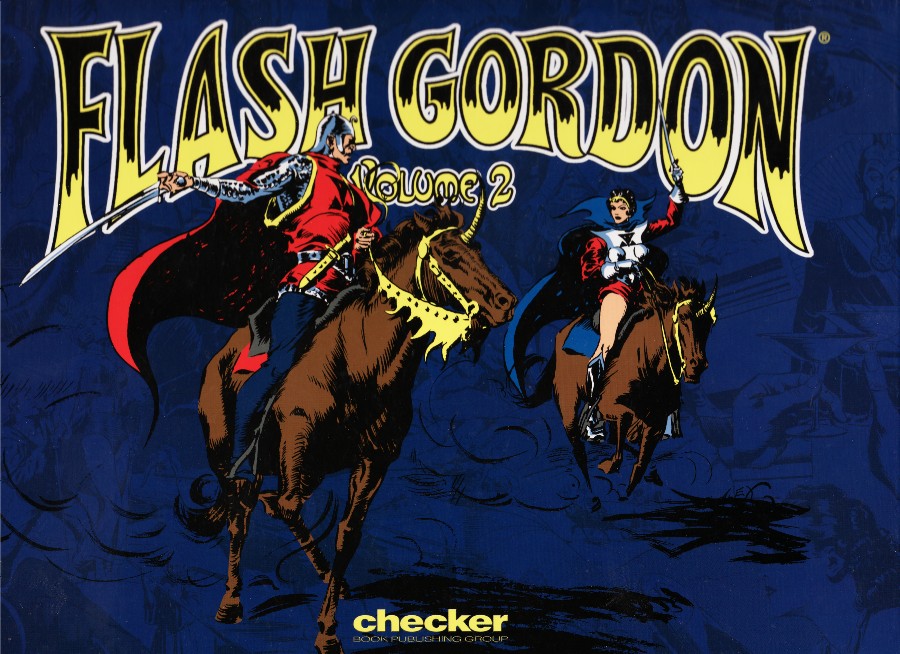Blogging Alex Raymond’s Flash Gordon, Part Five: “The Witch Queen of Mongo”
 “The Witch Queen of Mongo“ was the fifth installment of Alex Raymond’s Flash Gordon Sunday comic strip serial for King Features Syndicate. Originally printed between April 21 and October 13, 1935, “The Witch Queen of Mongo” picked up the storyline where the fourth installment, “Caverns of Mongo” left off with Flash and Dale setting out to conquer the cave kingdom that was awarded to Flash following the tourney held by Ming and Vultan.
“The Witch Queen of Mongo“ was the fifth installment of Alex Raymond’s Flash Gordon Sunday comic strip serial for King Features Syndicate. Originally printed between April 21 and October 13, 1935, “The Witch Queen of Mongo” picked up the storyline where the fourth installment, “Caverns of Mongo” left off with Flash and Dale setting out to conquer the cave kingdom that was awarded to Flash following the tourney held by Ming and Vultan.
Writer/artist Alex Raymond benefitted greatly from the contributions of ghost writer Don Moore who developed characterization to bring much-needed balance to the nonstop parade of cliffhangers. The serial quickly sets the tone with Dale’s mounting frustration with Flash’s preference for continued adventures over settling down and marrying her. This development coincides with the introduction of Azura, the titular Witch Queen of the Kingdom of Syk.
 Azura is the second of Alex Raymond’s stunning exotic women of Mongo and rivals Aura in complexity and appeal. The Witch Queen’s descent from the heavens on a stair of flames is an iconic image that may have influenced Frank Frazetta’s cover art for Conan the Freebooter three decades later. Likewise, Flash’s Nordic-style horned helmet suggests the strip was a vital inspiration on the depiction of Robert E. Howard’s barbarian pulp hero.
Azura is the second of Alex Raymond’s stunning exotic women of Mongo and rivals Aura in complexity and appeal. The Witch Queen’s descent from the heavens on a stair of flames is an iconic image that may have influenced Frank Frazetta’s cover art for Conan the Freebooter three decades later. Likewise, Flash’s Nordic-style horned helmet suggests the strip was a vital inspiration on the depiction of Robert E. Howard’s barbarian pulp hero.
From the very start, the point is made that the Witch Queen’s “magic” is nothing more than advanced technology. The continued juxtaposition of the futuristic with medieval fantasy remained a potent formula for success with the stip.

 It gives me great pleasure, now, to invite Leah here to talk to us about Ideomancer and its exciting current issue.
It gives me great pleasure, now, to invite Leah here to talk to us about Ideomancer and its exciting current issue. Confession: I watch almost no TV. Well, that’s not quite true: NFL football, an occasional news program, and the odd episode of The Simpsons aside, I watch no TV. Lost is lost on me. There aren’t enough hours in the day for 24. The Sopranos? Fuggedaboutit. There are too many good books to be read in the world and not enough time for television.
Confession: I watch almost no TV. Well, that’s not quite true: NFL football, an occasional news program, and the odd episode of The Simpsons aside, I watch no TV. Lost is lost on me. There aren’t enough hours in the day for 24. The Sopranos? Fuggedaboutit. There are too many good books to be read in the world and not enough time for television. During the course of the past few days I’ve had the pleasure of chatting with a goodly number of writers. It’s been good for my soul to talk shop with knowledgeable peers. But one question that invariably cropped up concerned my method of writing. How did I prepare my drafts? And as I explained it, curious looks would blossom over the visages of my brother-and-sister scribes.
During the course of the past few days I’ve had the pleasure of chatting with a goodly number of writers. It’s been good for my soul to talk shop with knowledgeable peers. But one question that invariably cropped up concerned my method of writing. How did I prepare my drafts? And as I explained it, curious looks would blossom over the visages of my brother-and-sister scribes.
 In his famous essay “The Simple Art of Murder” (1944) noir author Raymond Chandler discusses the separation between loftiness of subject in writing and its literary success:
In his famous essay “The Simple Art of Murder” (1944) noir author Raymond Chandler discusses the separation between loftiness of subject in writing and its literary success:
